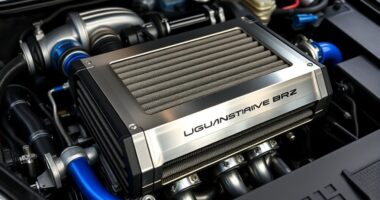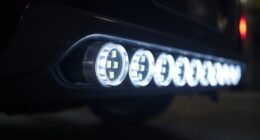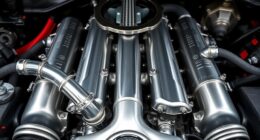Upgrading your Subaru Forester or Outback’s camshaft can boost power, improve throttle response, and enhance overall engine performance, especially if you’ve modified your turbo system or want higher RPM capabilities. Choose from high-quality options like Kelford, Brian Crower, or regrinds for a budget-friendly boost. Proper installation and tuning are key to avoiding damage and maximizing gains. Keep going to discover how to select the best camshaft for your driving style and setup.
Key Takeaways
- Upgrading camshafts can boost power and high-RPM performance in Subaru Forester and Outback, especially with turbo models.
- Choose cam profiles like Kelford R-199-A or Crower turbo for airflow optimization and increased boost handling.
- Compatibility with stock valve springs varies; higher-performance setups may need upgraded springs and supporting components.
- Proper installation and ECU tuning are essential to maximize gains and ensure engine reliability after camshaft upgrades.
- Consider supporting mods like exhaust, fuel system, and valvetrain components for optimal performance and durability.
Understanding Camshaft Basics and Their Role in Performance
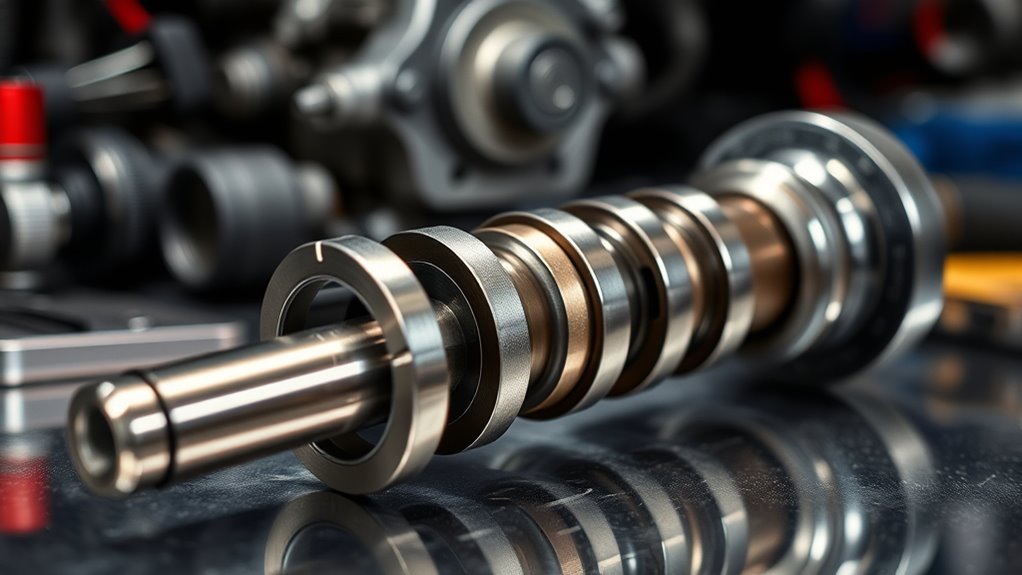
Understanding how a camshaft works is essential if you’re looking to boost your Subaru Forester or Outback’s performance. The camshaft controls valve timing through lobes that rotate to open and close intake and exhaust valves. It determines valve lift by multiplying lobe height with rocker ratio, affecting airflow into the engine. The shape of the lobes also manages valve duration—how long the valves stay open—impacting engine breathing at different speeds. It syncs with the crankshaft via a timing chain or belt, ensuring precise piston and valve coordination. Components like lobes, journals, and rocker arms work together to regulate airflow and optimize power. Changing camshaft specs influences performance variables like lift, duration, and overlap, which can markedly enhance your engine’s efficiency and output.
Factory Camshaft Specifications for Subaru Forester and Outback
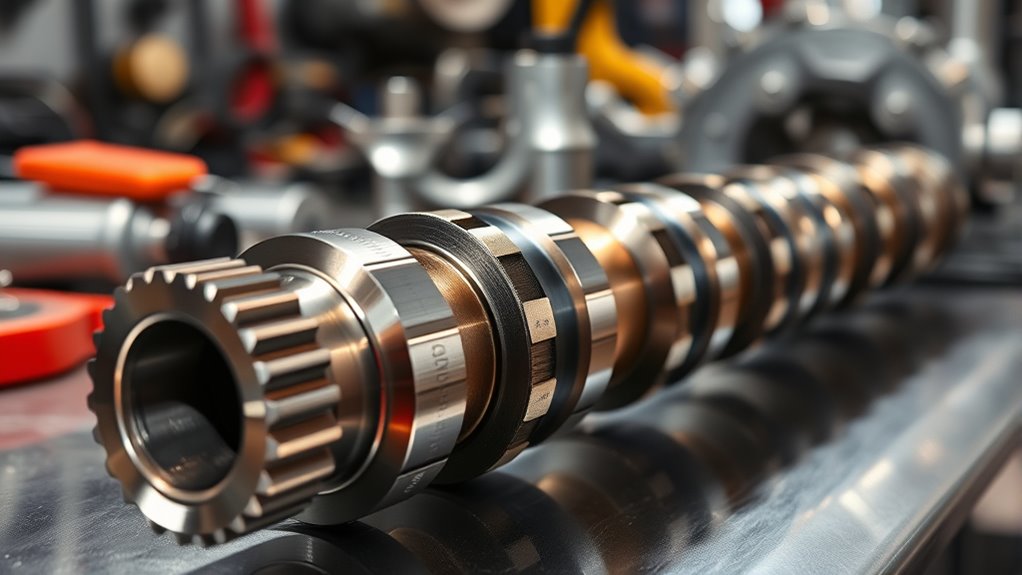
Factory camshafts in Subaru Forester and Outback are engineered from durable materials like hardened steel or alloys to withstand high-stress valve operation. They feature a DOHC layout on turbocharged 2.5L H4 engines and select naturally aspirated models, ensuring precise timing and lift profiles optimized for emissions and power. The lobes are carefully machined for OEM valve timing, and the camshafts are paired with timing gears or sprockets for synchronized operation with the crankshaft. Different part numbers correspond to specific engine types, model years, and trims, with revisions over time to accommodate updates. Turbo models have distinct camshafts from naturally aspirated versions, and each camshaft is designed to work seamlessly with factory components, backed by Subaru’s warranty for reliability. Camshaft specifications are crucial for optimal engine performance and longevity. Additionally, understanding factory design standards helps ensure compatibility and proper performance when considering upgrades or replacements, especially regarding performance gains that can be achieved through proper camshaft selection.
When to Consider Upgrading Your Camshaft

Deciding whether to upgrade your Subaru Forester or Outback’s camshaft depends on your performance goals and how you plan to use the vehicle. If you’re aiming for significant power increases, especially with a turbocharged setup, and are willing to invest in tuning and supporting modifications, it might be time to think about an upgrade. Higher rpm performance, better top-end power, and a more aggressive driving style can justify the expense. However, if you primarily use your vehicle for daily commuting or low-speed driving, upgrading may not be necessary and could even reduce reliability or fuel efficiency. Also, consider your engine’s current state; if you’re planning other modifications or want improved high-RPM performance, a camshaft upgrade could be beneficial. For those seeking the best earplugs for concerts, ensuring optimal hearing protection during high-intensity driving situations might also influence your upgrade decisions.
Kelford Cams: Features and Benefits for Subaru Engines
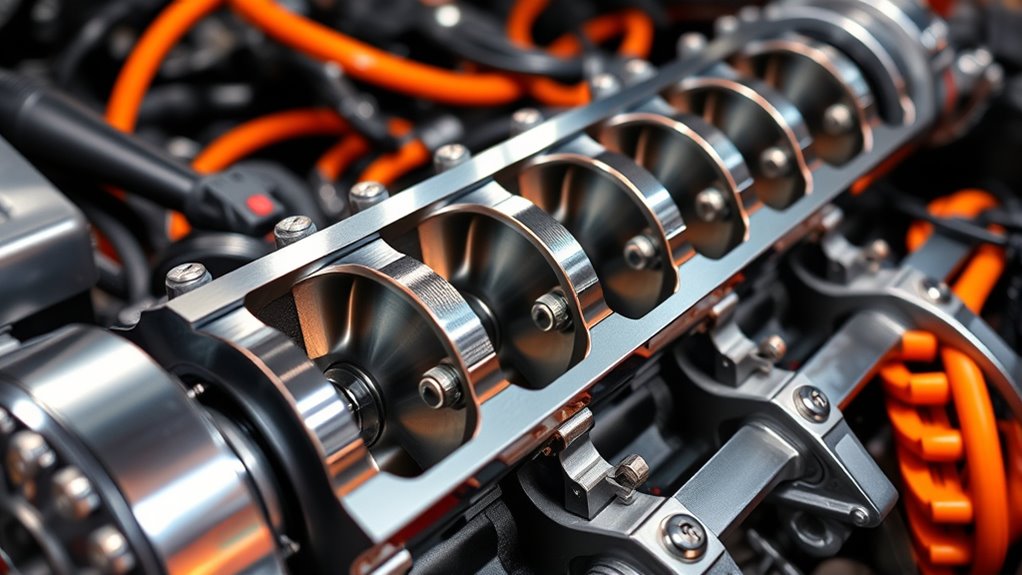
Kelford cams offer a versatile and high-performance upgrade option for Subaru engines, compatible with models like FA20F, FA24F, EJ257B, and EJ25. They boost power, especially when combined with turbo upgrades, handling high RPMs and boost pressures up to 30 lb. Some sets work with stock valve springs; others require upgrades for higher performance. They improve driveability, reduce tappet noise, and enhance valve-to-piston clearance. Their specific durations and lifts, such as 256/260 for EJ25, optimize performance. Many cams feature ICE technology and dual AVCS compatibility for precise control. Here’s a quick comparison of cam features:
| Feature | Benefit |
|---|---|
| ICE Technology | Better combustion efficiency |
| Dual AVCS Compatibility | Precise cam timing control |
| High RPM Handling | Suitable for racing applications |
Additionally, understanding wear resistance properties can help in selecting durable camshafts for long-term performance. Incorporating advanced materials can further enhance durability and lifespan in demanding conditions.
Exploring Brian Crower Camshaft Options for Turbocharged Builds

If you’re upgrading your turbocharged Subaru, selecting the right Brian Crower camshaft can substantially boost performance and reliability. BC offers options tailored for EJ205, EJ257, and EJ255 engines, with Stage 2 and Stage 3 profiles designed for different goals. Stage 2 cams, like BC0601, deliver high lift and shorter duration, ideal for street and strip, with easy installation and recommended ECU tuning to disclose power and higher RPM potential. Stage 3 cams are built for race use, featuring longer duration for maximum RPM and requiring extensive engine modifications, including ECU tuning and head work. BC0620 and BC0621 are popular choices for EJ257 and EJ255 engines, offering performance suited for demanding builds. To optimize timing, adjustable cam gears, like BC8860, help fine-tune engine performance without major disassembly. Incorporating nutrient-rich camshafts can also contribute to overall engine health and longevity during high-performance use.
Regrinding OEM Camshafts: Pros and Cons for Budget Builds
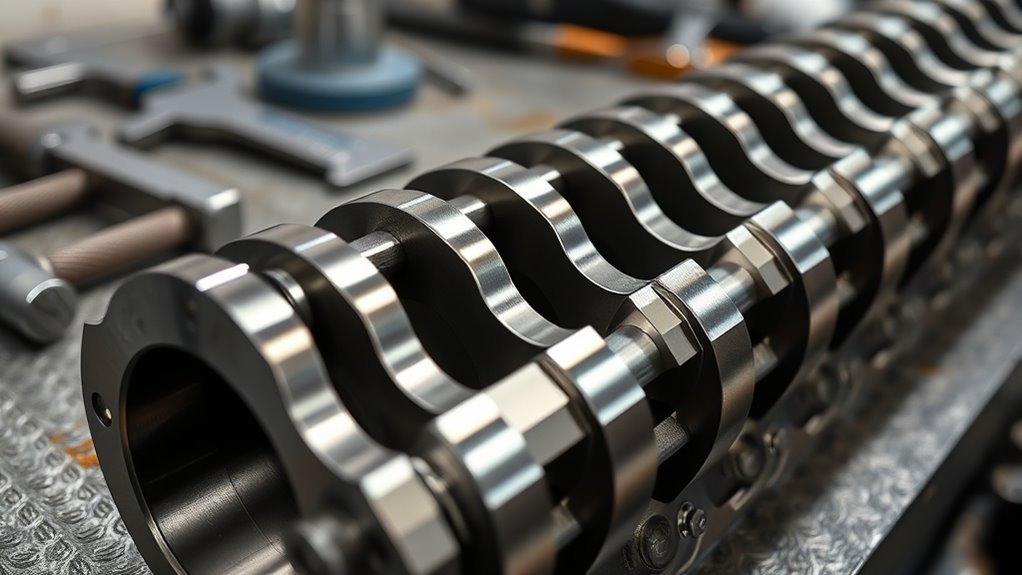
When working within a tight budget, regrinding OEM camshafts can be a practical way to boost your Subaru’s performance without the high costs of aftermarket parts. Regrinding typically costs between $200 and $500, making it more affordable than new performance camshafts, which can be considerably pricier. It can provide noticeable improvements by adjusting lift, duration, and lobes, but it won’t match the gains of specially designed aftermarket cams. Compatibility depends on the camshaft material, and not all parts are suitable for regrinding. The process involves precise material removal and surface finishing, requiring skilled expertise. While regrinding offers cost savings, it has performance limits and potential risks, such as material constraints or fatigue. Additionally, considering performance enhancements like camshaft regrinding can help maximize your vehicle’s potential without breaking the bank. Understanding the material properties of OEM camshafts is crucial to determine if regrinding can be safely performed without compromising durability. Furthermore, evaluating the manufacturing quality of OEM parts can influence the regrinding process and its outcomes. Incorporating techniques from remote hackathons can sometimes inspire innovative approaches to custom modifications or tuning processes.
Compatibility Tips for Subaru Camshaft Upgrades
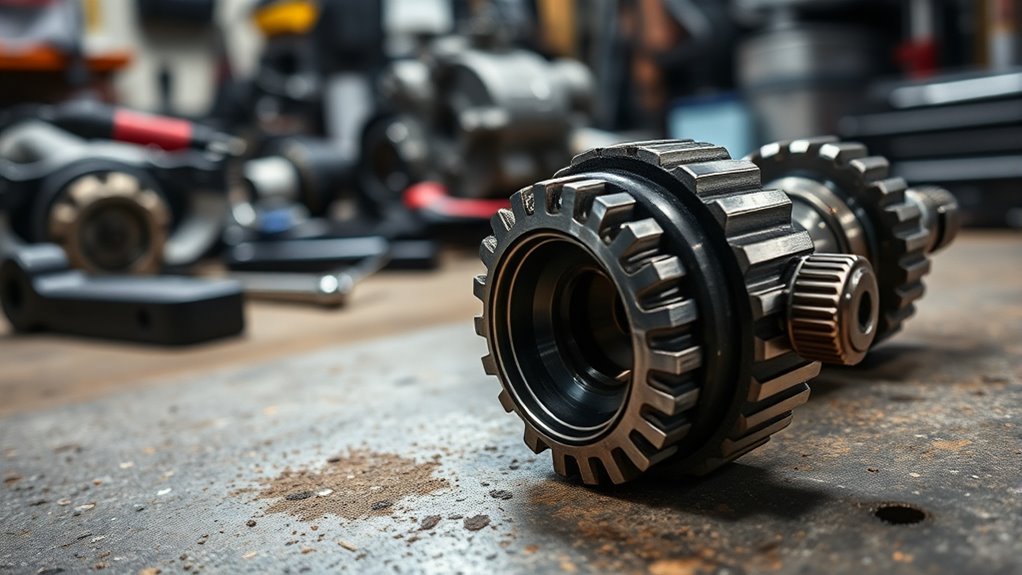
Selecting the right camshaft for your Subaru upgrade requires careful attention to compatibility, as not all camshafts fit every engine or setup. To guarantee a smooth upgrade, consider these key factors:
- Engine and Model Specifics: Camshafts are designed for specific engines like the EJ25 or models with AVCS systems. Confirm your vehicle’s engine type before choosing.
- Materials and Design: High-performance camshafts made from billet steel or similar materials provide durability. Match the camshaft’s lift, duration, and profile to your desired performance goals.
- Supporting Components: Upgrading valve springs, pistons, and electronic controls may be necessary to handle increased lift and duration, preventing engine damage and ensuring ideal operation.
Careful selection maximizes performance and reliability, preventing costly mismatches.
Selecting the Right Camshaft Based on Your Driving Goals

Choosing the right camshaft depends heavily on your driving goals, whether you prioritize low-end torque, high-RPM power, or a balanced performance. If you want maximum top-end power for racing, consider cams like Brian Crower Stage 3 with longer duration and higher lift, but be prepared for upgraded valve springs and proper tuning. For daily street driving and mid-range responsiveness, Brian Crower Stage 2 or OEM cams offer a good balance with moderate duration and lift. Turbocharged engines benefit from cams designed for airflow, like Kelford R-199-A or Crower turbo-specific profiles, supporting higher boost and RPM. Naturally aspirated setups may see gains from Delta regrinds, but they require careful assessment of engine condition. Proper performance tuning is essential to maximize gains and ensure reliability with your cam upgrade. Additionally, ensuring your valve train components are compatible and durable is crucial when selecting a camshaft for your Subaru engine. Considering engine modifications such as upgrades to the fuel system or exhaust can further optimize performance gains and reliability. It’s also important to understand the personality and behavior of your vehicle to choose a cam profile that complements its overall driving style and characteristics. Incorporating sensor technology can help monitor the engine’s response and optimize the camshaft’s performance for your specific setup.
Installation and Tuning Considerations for Camshaft Upgrades

Installing a camshaft upgrade requires careful preparation to guarantee proper engine function and longevity. First, confirm you have clear access to the engine by removing valve covers, rocker shafts, and cam timing sprockets as needed. Second, gather specific tools like camshaft removal tools to simplify the process. Third, inspect the head surface for damage or gasket issues, replacing components if necessary. When installing, follow these steps:
Ensure engine access, gather tools, inspect surfaces, and follow proper installation steps for a successful camshaft upgrade.
- Properly align the camshaft before installation to prevent timing issues.
- Use RTV sealant and assembly lube on caps for sealing and lubrication.
- Torque camshaft bolts according to OEM specifications and test rotation for smooth operation.
- Ensure correct engine timing is maintained to optimize performance and prevent potential damage. Additionally, verify the camshaft position sensors are properly connected and functioning to ensure accurate engine management. It is also advisable to perform a thorough engine tuning after installation to maximize gains and reliability. Proper valve train adjustment is essential to prevent issues such as noise or uneven wear. Moreover, a comprehensive quality control check can help identify any installation issues early on.
Finally, re-tune the ECU, adjust fueling, and verify ignition timing for peak performance.
Frequently Asked Questions
How Do Camshaft Upgrades Affect Emissions Compliance?
When you upgrade your camshaft, you change how your engine breathes, which can impact emissions. Increased lift and duration might boost power but could also raise emissions if not properly managed. To stay compliant, you need to follow regulations, use tested parts, and possibly tune your engine accordingly. Ensuring your upgrades have the right certifications, like CARB approval, helps prevent legal issues and keeps emissions within legal limits.
Can I Upgrade Cams Without Changing the Valvetrain Components?
You might wonder if you can upgrade cams without changing valvetrain components. Generally, if you’re installing mild cams with lower lift and duration, your stock valvetrain might handle it. However, for high-lift or aggressive cams, you’ll need to upgrade valve springs and retainers to prevent wear and damage. Always verify compatibility, as neglecting necessary upgrades can lead to premature component failure and reduced engine reliability.
What Are the Signs of Camshaft Wear or Failure?
Imagine your engine’s heart whispering warnings when its camshaft falters. You’ll notice scoring or pitting on the lobes, like scars telling tales of wear. You might hear ticking or knocking, as if the engine’s voice is strained. Reduced power, rough idling, or stalling signal the internal gears are slipping. Metal debris in oil or check engine lights confirm that your camshaft’s integrity is compromised, urging immediate attention.
Are Aftermarket Cams Compatible With Stock ECU Tuning?
You can’t simply slap in aftermarket cams and expect the stock ECU to handle it properly. Without custom tuning, the ECU won’t adjust fuel, timing, or VVT correctly, which can cause poor performance or engine damage. To guarantee compatibility, you’ll need a dedicated ECU tune that matches your camshaft specs. Otherwise, you risk check engine lights, drivability issues, and potential long-term engine harm.
How Does Camshaft Choice Influence Fuel Economy?
You might wonder how camshaft choice impacts fuel economy. A milder camshaft improves idle quality and helps your engine run more efficiently in daily driving, saving fuel. Conversely, aggressive cams boost power at high RPMs but can lower fuel efficiency because they increase engine load and consumption. By selecting a camshaft that balances performance with economy, you can optimize fuel usage while maintaining decent drivability.
Conclusion
Upgrading your Subaru’s camshaft can open impressive performance gains, but it’s not a decision to take lightly. Will you choose a high-quality aftermarket option or stick with regrinding OEM parts? The right camshaft can transform your driving experience—if you select wisely and tune properly. So, are you ready to push your Forester or Outback to new heights? The next step awaits—are you prepared to make it happen?






